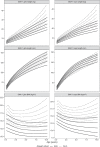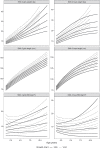Growth patterns in children with spinal muscular atrophy
- PMID: 34481516
- PMCID: PMC8418717
- DOI: 10.1186/s13023-021-02015-9
Growth patterns in children with spinal muscular atrophy
Abstract
Background: Spinal muscular atrophy (SMA) is a neuromuscular disorder characterized by muscle atrophy and weakness. SMA type 1 (SMA1) is the most severe form: affected infants are unable to sit unaided; SMA type 2 (SMA2) children can sit, but are not able to walk independently. The Standards of Care has improved quality of life and the increasing availability of disease-modifying treatments is progressively changing the natural history; so, the clinical assessment of nutritional status has become even more crucial. Aims of this multicenter study were to present the growth pattern of treatment-naïve SMA1 and SMA2, and to compare it with the general growth standards.
Results: Body Weight (BW, kg) and Supine Length (SL, cm) were collected using a published standardized procedure. SMA-specific growth percentiles curves were developed and compared to the WHO reference data. We recruited 133 SMA1 and 82 SMA2 (48.8% females). Mean ages were 0.6 (0.4-1.6) and 4.1 (2.1-6.7) years, respectively. We present here a set of disease-specific percentiles curves of BW, SL, and BMI-for-age for girls and boys with SMA1 and SMA2. These curves show that BW is significantly lower in SMA than healthy peers, while SL is more variable. BMI is also typically lower in both sexes and at all ages.
Conclusions: These data on treatment-naïve patients point toward a better understanding of growth in SMA and could be useful to improve the clinical management and to assess the efficacy of the available and forthcoming therapies not only on motor function, but also on growth.
Keywords: Growth; Nutritional status; Percentiles; Spinal muscular atrophy.
© 2021. The Author(s).
Conflict of interest statement
Some authors (EB, CA, CB, AD, MP) are members of the European Reference Network for Neuromuscular Diseases (ERN EURO-NMD). GiBa has received speaker and consultancy honoraria from AveXis, Inc., Roche, PTC, and Sarepta Therapeutics, but he received no funding for this specific study. All the other authors have no conflicts of interest relevant to this article to disclose.



